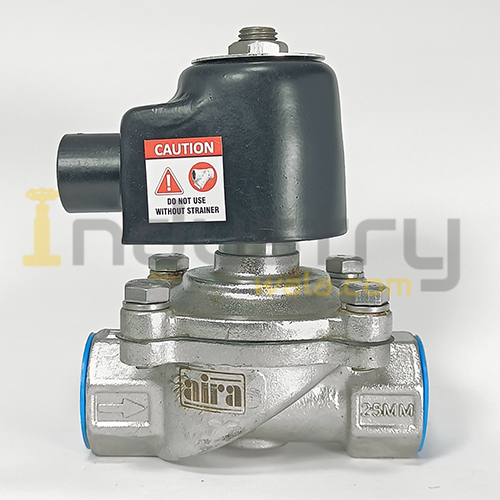Diaphragm Solenoid Valves For High Temperature Upto 170°C Screwed End Normally Closed Aira GTD 1/2″ to 2″
₹2,377 – ₹6,944
This Solenoid valve works at gravitational pressure that is, 0kg pressure is required to operate this valve.
Brand : Aira
Model : GTD
Body MOC : CF8
Diaphragm : PTFE
Media : Steam
Pressure : 0 to 5KG/Cm2
Temeprature : Upto 170C
For more types of solenoid valves, click here.
Product Information
Description
Additional information
Reviews
Description
Solenoid Valve – How They Work
A solenoid valve is an electrically controlled valve. The valve features a solenoid, which is an electric coil with a movable ferromagnetic core (plunger) in its center. In the rest position, the plunger closes off a small orifice. An electric current through the coil creates a magnetic field. The magnetic field exerts an upwards force on the plunger opening the orifice. This is the basic principle that is used to open and close solenoid valves.How does a solenoid valve work?
A solenoid valve consists of two main components: a solenoid and a valve body. A solenoid has an electromagnetically inductive coil around an iron core at the center called the plunger. At rest, it can be normally open (NO) or normally closed (NC). In the de-energized state, a normally open valve is open and a normally closed valve is closed. When current flows through the solenoid, the coil is energized and creates a magnetic field. This creates a magnetic attraction with the plunger, moving it and overcoming the spring force. If the valve is normally closed, the plunger is lifted so that the seal opens the orifice and allows the flow of the media through the valve. If the valve is normally open, the plunger moves downward so that the seal blocks the orifice and stops the flow of the media through the valve. The shading ring prevents vibration and humming in AC coils. Learn more about solenoid valves here. For more types of solenoid valves, click here. Product Catalogue.Additional information
Reviews








